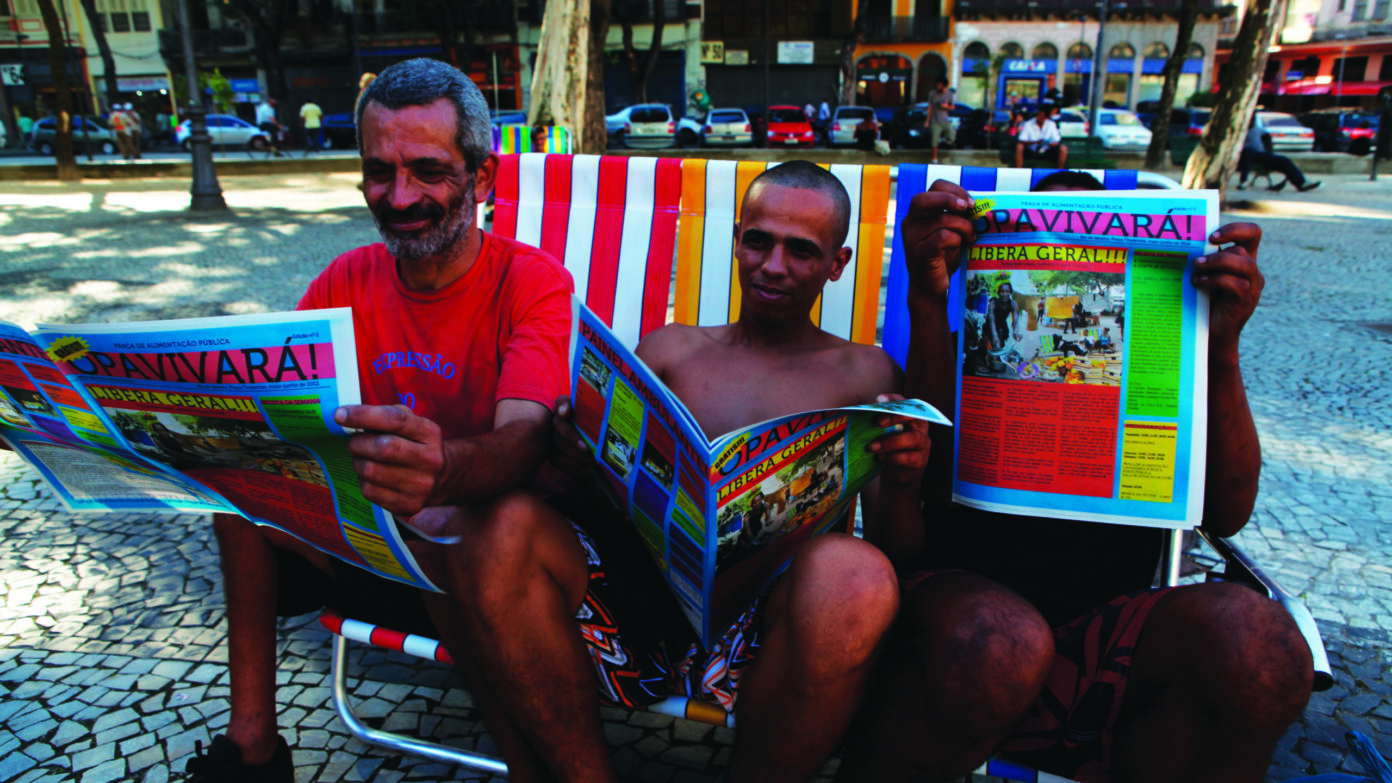Bring together all social classes
Roberto Cabot: What are the relationships between the types of actions you are doing and these spontaneous things which are happening in the population—do you think it is in the spirit of the times, that things are happening by themselves? Is this a phenomenon you notice and that you integrate into your work, or is it a much more risky relationship?
Opavivará: We think a lot about that dimension. For instance, for the installation of the kitchen on Tiradentes Square, the work was called Opavivará Ao Vivo (Opavivarà Live), but the kitchen itself was called Praça de Alimentação Pública (Public Food Plaza), in direct reference to the mall’s food plaza: an ironic name for a space where people will meet and share among themselves. But there are a lot of things in our actions which are purely coincidental, for instance our work on the camelô. The fundamental underpinning of our work is communicating with the population, because we only intervene in the public space and we want to reach as wide and diverse an audience as possible. We seek a language of camouflage to blend with the language of the city. It would be meaningless to show up with a fully completed project in this place which is a delirium, a mix of languages. Opavivará looks like a variety theatre: we appropriate the major news topics or things we catch in mid-air and then suddenly make headlines with them.
Roberto Cabot: Most of today’s conflicts, these spontaneous movements of society, are nearly always linked to issues of public space and mobility. But strangely there are very few specific demands on the subject. In my opinion, the central issue is the right to make use of the city—we now have an entire population who wants to enjoy its city.
Opavivará: Bearing in mind that enjoying means being able to consume. What’s the use in coming and going? Consuming. Mobility itself is a consumer item. For that matter, there is a major automobile boom in Brazil, with the lower middle-class starting to purchase cars.
Roberto Cabot: There has been segregation in mobility in Brazil with expensive, comfortable buses with air-conditioning on the one hand, and cheap, old things for the masses on the other hand.
Opavivará: This price difference was true until last year, but since the protests prices have been controlled. There is a lot of discussion about consumption but we have to take care because one quickly falls into an anti-consumerist Marxist rhetoric while Opavivará has always perceived trade as a moment of exchange, of interconnection. If we understand the city as a place for relationships, we must work with trade, with the market.
Roberto Cabot: To conclude, I want to talk about an emblematic space for Rio which you think about a lot: the beachfront. It is a very strange space because it is public and, once more, we had problems: with the arrival of the metro, of mobility, suddenly the elite found itself invaded on its beaches. Given that constitutionally, the beachfront is a public domain administrated by the Navy—that is to say, it belongs to everyone. But then suddenly, there is this problem: the “invasion.”
Opavivará: Our beachfront has never been calm, it has always been very noisy. And there has always been a bit of diversity due to the favelas embedded within the posh districts, but it was different because the inhabitants of these favelas worked for the rich.
Roberto Cabot: Yes, in the end, this serving “middle-class” had adopted the habits of the rich—a way of behaving, not being too noisy, not touching people, etc. They had assimilated the restrictions of that education. Everything has changed with the arrival of the suburbans: people with very different bodies, educations, and behaviors; it was disturbing. The elite still had retained old-fashioned attitudes. That is why it is interesting to work on bodies and their appropriation of space as you are doing.
Opavivará: Yes, an aspect of our work is dedicated to fostering these relationships, building an impossible and unhoped for context where all the social classes within the city meet in the public space and also fight against bias and fears. I think the beach is a perfect urban model. In Rio, the entire city is on the beachfront: there is the mall, several clubs. It is like an extension of people’s homes because they are there in the public space yet stay in their own intimacy, naked, lying down. It is an open space, with this geographic condition: the city stops here, it goes no further.



















